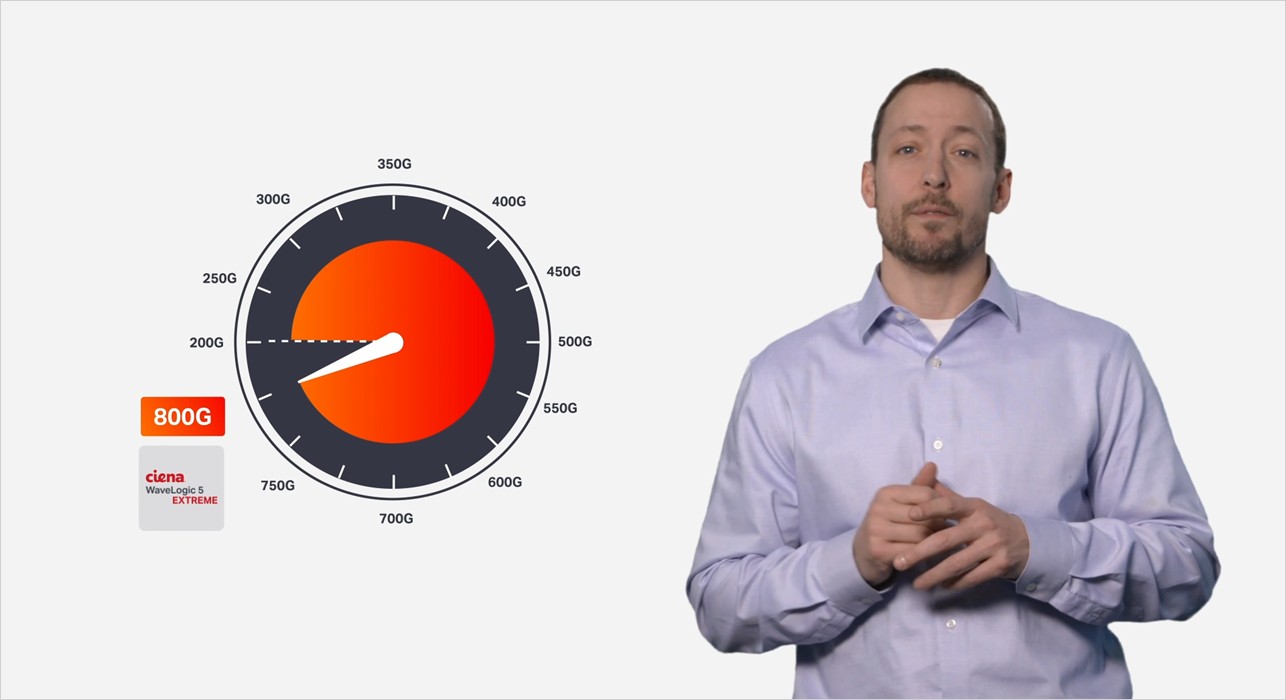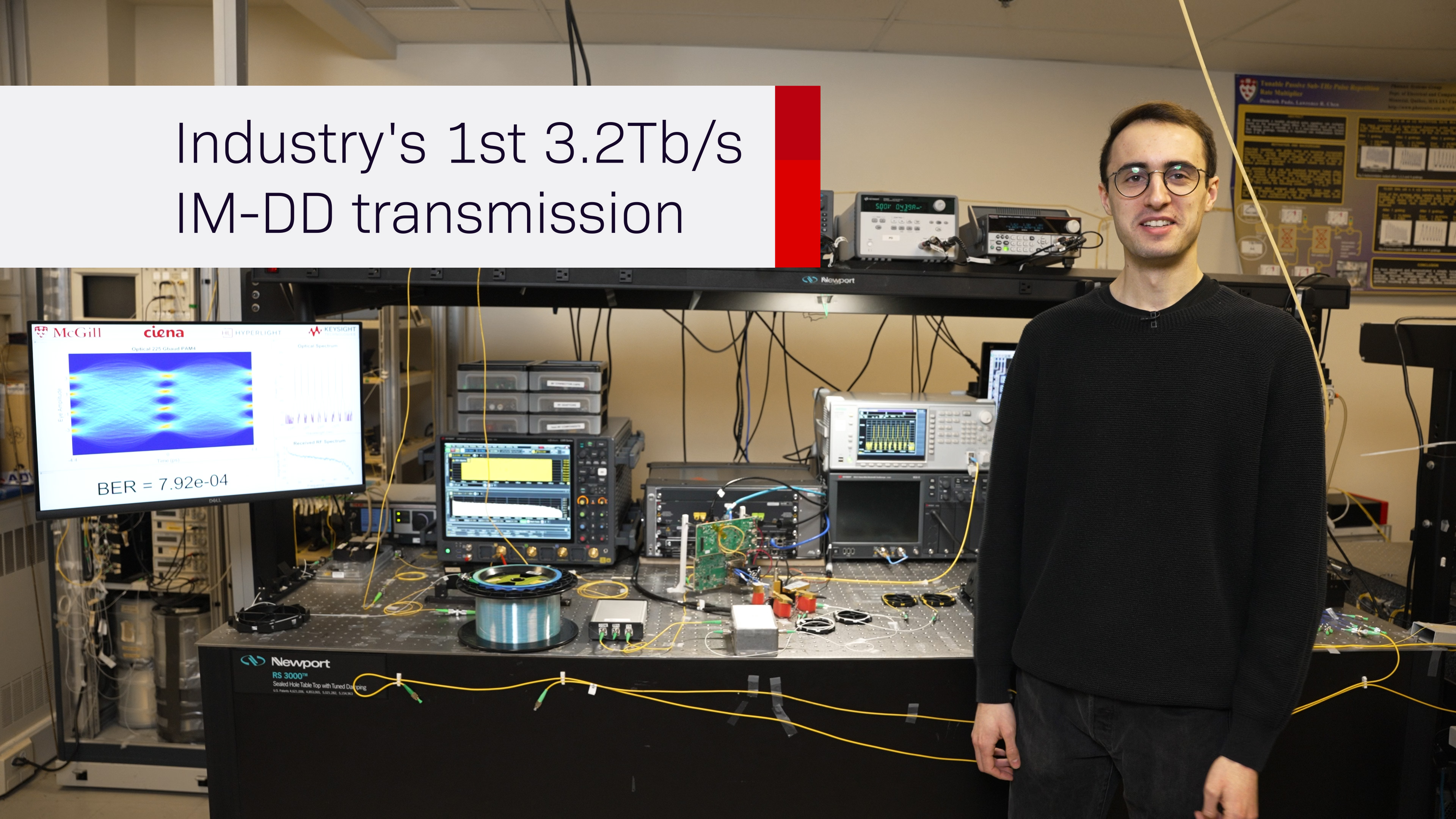800G adoption soars in 2020
With the current physical distancing and remote work environment we are living in, introducing new products or technology into networks is definitely more challenging for service, cloud, and content providers this year. At the same time, servicing the world’s connectivity needs is more critical than ever. So, what happens when new technology becomes available that tackles a key challenge that providers are facing – the need to satisfy user requirements for higher bandwidth connectivity while at the same time reduce network costs? How quickly will that new technology be adopted?
After bringing to market the industry’s first programmable 800G solution with WaveLogic 5 Extreme (WL5e) earlier this year, we are seeing this story unfold
firsthand. After just over 6 months of commercial availability, the tally rests at an incredible 65 customers
and 3700 coherent modems shipped by the end of October, which surprisingly, is the fastest we have seen this many
customers adopt coherent technology – more than twice the number of customers than with 400G over the same
time period.
After just over 6 months of commercial availability, the tally rests at an incredible 65 customers and 3700 coherent modems shipped by the end of October, which surprisingly, is the fastest we have seen this many customers adopt coherent technology – more than twice the number of customers than with 400G over the same time period.
What are the reasons behind the strong customer adoption? Of course, WL5e with its industry-leading performance and the economic benefits it provides are key benefits. Another important aspect is the availability of ALL the requisite elements for widescale deployment, including support across multiple platforms, the ability to supply in volume, link engineering and design tools, photonic line systems, multi-layer domain controller, and open APIs.
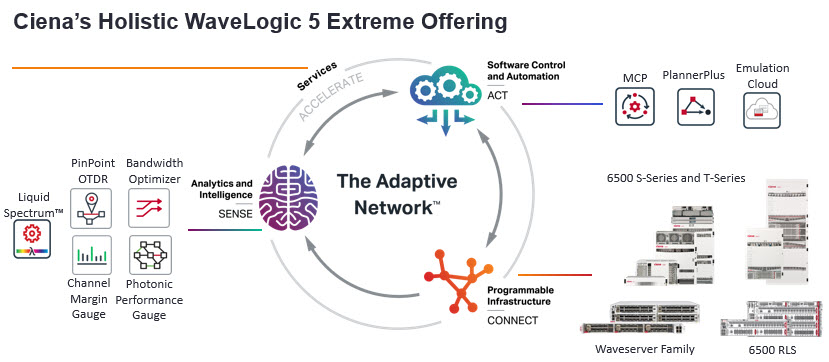
44 WL5e customers use the 6500, 24 selected Waveserver 5 (some customers have deployed both!)
The map below provides a view of where the deployments are happening for the different customer networks - it’s thrilling to see how the new technology is so quickly being rolled out across the globe and across different applications!
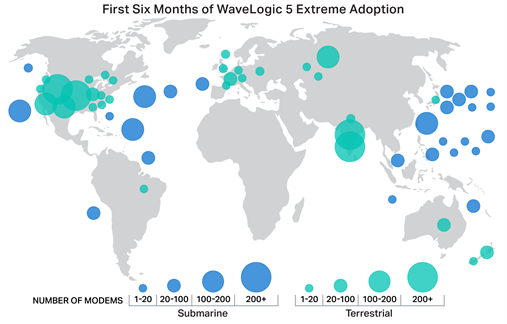
Here are some additional details and insights around 800G technology adoption to date.
1. Network Providers across the globe adopt WaveLogic 5 Extreme for a variety of applications
Interest in WL5e programmable 800G is global and for all applications. Customer excitement with what can be achieved is palpable in the numerous announcements: 1st 800G globally with Southern Cross, 1st 400GbE over 800G with Verizon in the US, 1st 800G in Europe with Deutsche Telekom, 1st 800G in Russia with GlobalNet, 1st 800G in New Zealand with Vodafone New Zealand, 1st 800G in Australia with Telstra, 1st 800G in Japan with NTT Com, and finally, 1st and longest 800G wavelength across 970km in Canada with TELUS.
It’s been a very busy and exciting 6 months!
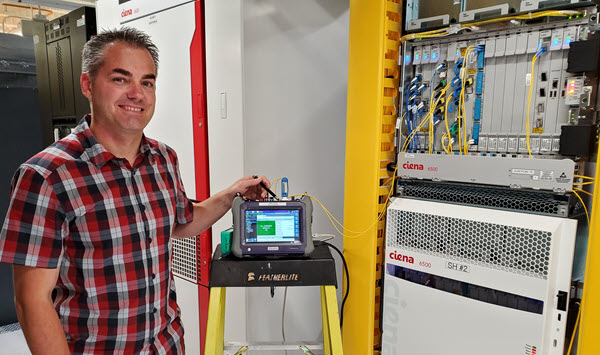
Jean Gregoire, Network Integrity Sr Design Specialist at TELUS, standing in front of the WL5e equipment being tested in Quebec City.
Network providers are achieving the benefits of WL5e across a diverse range of applications.
- NTT Communications Corporation is deploying an 800G DCI network with WL5e to support rapid growth of 5G, gaming and cloud services
- Spark is building a new country-wide, next generation, programmable, and self-healing network with WL5e in New Zealand, increasing capacity in the network by up to eight times to support 5G services
- Hawaiki is deploying WL5e, more than doubling wavelength capacity across its transpacific submarine cable to support surging customer capacity demand, achieving 500Gb/s single-wavelength throughput across 9,000km
- Sparkle deployed 450Gb/s wavelengths with WL5e across 10,476km on the Curie submarine cable interconnecting the Americas, achieving 30% increase in spectral efficiency, improving capacity and speed on the Chile to U.S. route
- Windstream is building its new National Converged Optical Network (NCON) with WL5e and 6500 RLS integrated C&L-band photonic line system, enabling capacity between Windstream’s Tier 1, 2, and 3 markets to major U.S. data centers, submarine cable landing stations, and cross-border gateways
- RETN is deploying WL5e wavelengths across its existing 3rd party line system in Central Europe, to enable highest level of performance and network utilization as well as efficient high capacity 100GbE and 400GbE connectivity for its customers
- Vodafone New Zealand is leveraging its existing 6500 installed base, achieving record transmission speeds to support growing, yet constantly fluctuating, demands for digital services while enabling a greener, less power-hungry network: doubling the data throughput for each hardware module deployed and reducing energy consumption by 50 percent.
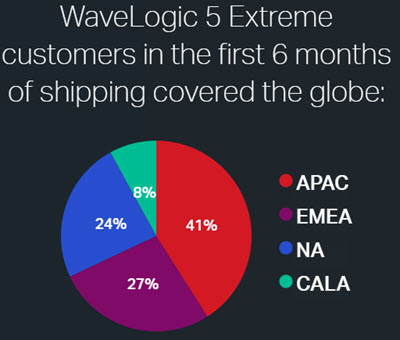
2. Submarine operators are early adopters
As seen with previous high-performance coherent technology introductions, it comes as no surprise that submarine operators represent a significant portion of the early adopters. They have built their networks using the Open Cables model that offers them the freedom to choose the Submarine Line Terminal Equipment (SLTE), including coherent optical modems, separately from the submerged wet plant.
Many submarine operators go to tender for every new significant capacity add to select the very best in modem technology, when they need it, to maximize spectral efficiency and return on investment on their submerged cable assets. With very fast standardization cycles, many of the WL5e submarine deployments are already carrying live traffic today.
In addition to Southern Cross (transpacific), Sparkle (Chile to the US) and Hawaiki (transpacific) GeoMesh Extreme deployments mentioned above, other early adopters include:
- SUB.CO with its Australian entity APX Partners is upgrading its INDIGO submarine cable, which connects Perth and Sydney, Australia and Singapore, with WL5e to support growing virtual connectivity needs in the Asia-Pacific region. WL5e is delivering 500 Gb/s single-wavelength channels speeds across the submarine cable network, providing lower latency, greater scale, and increased economic efficiencies
- Aqua Comms is leveraging WL5e to deliver 20Tb/s along its various transatlantic submarine routes. This upgrade enables Aqua Comms to accelerate delivery lead times, create a flexible product set, improve cost optimization, and enable its customers to cater to increasing consumer demands
- GCI is upgrading its Alaska United (AU) East and AU West cables with WL5e to better serve bandwidth surges from their wholesale, federal government, and content providers customers
3. Hyperscale DCI connectivity drives higher adoption rates
And finally, although not publicly announced, bandwidth demand from hyperscalers is an important driver for WL5e traction, whether this demand is coming directly from hyperscalers themselves for their networks, or wholesale network providers deploying new capacity to service hyperscale demands.
Congratulations to the teams
With the unexpected challenges of this past year, it is particularly fitting to take a moment and recognize the
perseverance and resulting achievements associated with the leading-edge network deployments highlighted
above. Congratulations to the scientists and engineers for bringing this innovative technology to market and
to the network providers and installation teams who are powering new higher capacity to drive more efficient digital
connectivity for consumers and businesses alike!

